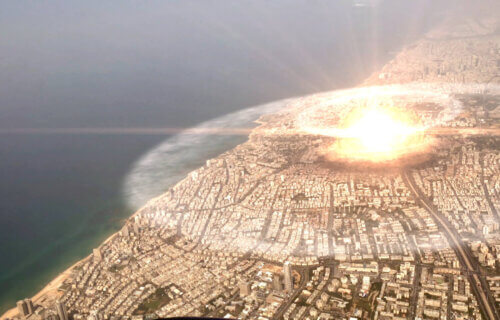NEW BRUNSWICK, N.J. — A nuclear war between the United States and Russia would cause a global famine, wiping out almost two-thirds of the world’s population, according to new research.
A team at Rutgers University say more than five billion people would die of hunger following a full-scale nuclear conflict. Vladimir Putin’s invasion of Ukraine has brought the threat back into reality for the first time in decades. The team’s study is based on computer simulations of such a conflict.
“The data tell us one thing: We must prevent a nuclear war from ever happening,” says lead author Professor Lili Xia in a university release.
How would nuclear war affect crop production?
Models showed firestorms would release soot into the upper atmosphere that would block out the Sun, resulting in global crop failure. Nine nations currently control more than 13,000 nuclear weapons. Even a clash between new nuclear states would decimate food production and result in widespread starvation.
The U.S. team calculated soot dispersal from five smaller India-Pakistan wars and a large U.S.-Russia nuclear conflict, based on the size of each country’s arsenal. A climate forecasting tool called the Community Earth System Model enabled the team to estimate the effect on maize, rice, spring wheat, and soybean production country-by-country.
The researchers also examined projected changes to livestock pastures and marine fisheries. Results show that in a localized war between India and Pakistan, global average caloric production decreased seven percent within five years.
In the worst-case scenario involving the U.S. and Russia, this would rise to 90 percent three to four years after the fighting ended. Crop declines would be the most severe in the mid-to-high latitude nations, including major exporters such as Russia and America.
It could trigger supply restrictions and cause severe disruptions in import-dependent countries in Africa and the Middle East. These would induce a catastrophic disruption of global food markets. Even a seven percent decline would exceed the largest drops since records began in 1961.
Worst-case scenario would cause global starvation in 2 years
Under the largest war scenario, more than 75 percent of the planet would be starving within two years. Using crops fed to livestock as human food or reducing waste would have minimal benefits.
“Future work will bring even more granularity to the crop models,” Xia says. “For instance, the ozone layer would be destroyed by the heating of the stratosphere, producing more ultraviolet radiation at the surface, and we need to understand that impact on food supplies.”
Climate scientists at Colorado University are creating detailed soot models for specific cities, such as Washington, D.C. Inventories of every building will provide a more accurate picture of how much smoke would be produced.
Study co-author Prof. Alan Robock says researchers already have more than enough information to know a nuclear war of any size would obliterate global food systems, killing billions of people in the process.
“If nuclear weapons exist, they can be used, and the world has come close to nuclear war several times,” Robock explains. “Banning nuclear weapons is the only long-term solution. The five-year-old UN Treaty on the Prohibition of Nuclear Weapons has been ratified by 66 nations, but none of the nine nuclear states. Our work makes clear that it is time for those nine states to listen to science and the rest of the world and sign this treaty.”
Earlier this year, another study found a nuclear war between the U.S. and Russia would also trigger a “Little Ice Age” lasting thousands of years. In the first month following detonation, average global temperatures would plunge by about 13 degrees Fahrenheit, more than during the most recent Ice Age.
The study is published in the journal Nature Food.
South West News Service writer Mark Waghorn contributed to this report.


Ive been tring to find nuclear protection suits and tents like used to be available online. They’re not really available anymore. However emergency supplies in general have improved.
A nuclear exchange would reduce the world to ash, dust, rubble and radioactivity from fallout. Not likely that most would survive the initial blasts and waves of thermonuclear heat so intense bodies and buildings would be gone in the blink of an eye. Forget about plant life. Strong delusion.
Watch Threads from 1984. It depicts the consequences out 10 years from a nuclear exchange
I think the author of this has overlooked radio active fall out, in effect all crops regardless of how productive they are would be radio active as would the fish of the sea . There would be nothing safe to eat except previously tinned foods, but you are going to need several hundred tons of it safely stored underground and even that would run out in time. Of course there would be no schools or doctors or television and you could risk it an go out to find a wind generator otherwise you are gong to live in the dark. In effect there would be nowhere to go to escape radiation you cannot live for years underground and probably your underground water supply would become irradiated given time .If there are a few who actually managed to survive the direct blast of nuclear weapons , it is odds on they will be dead due to starvation or cancer within 3 years , including all the mammals on earth too ! The only thing on the side of nuclear war is that President Putin and his family would die, too, and also to wage nuclear war on another nuclear power is tantamount to committing your own country to national suicide